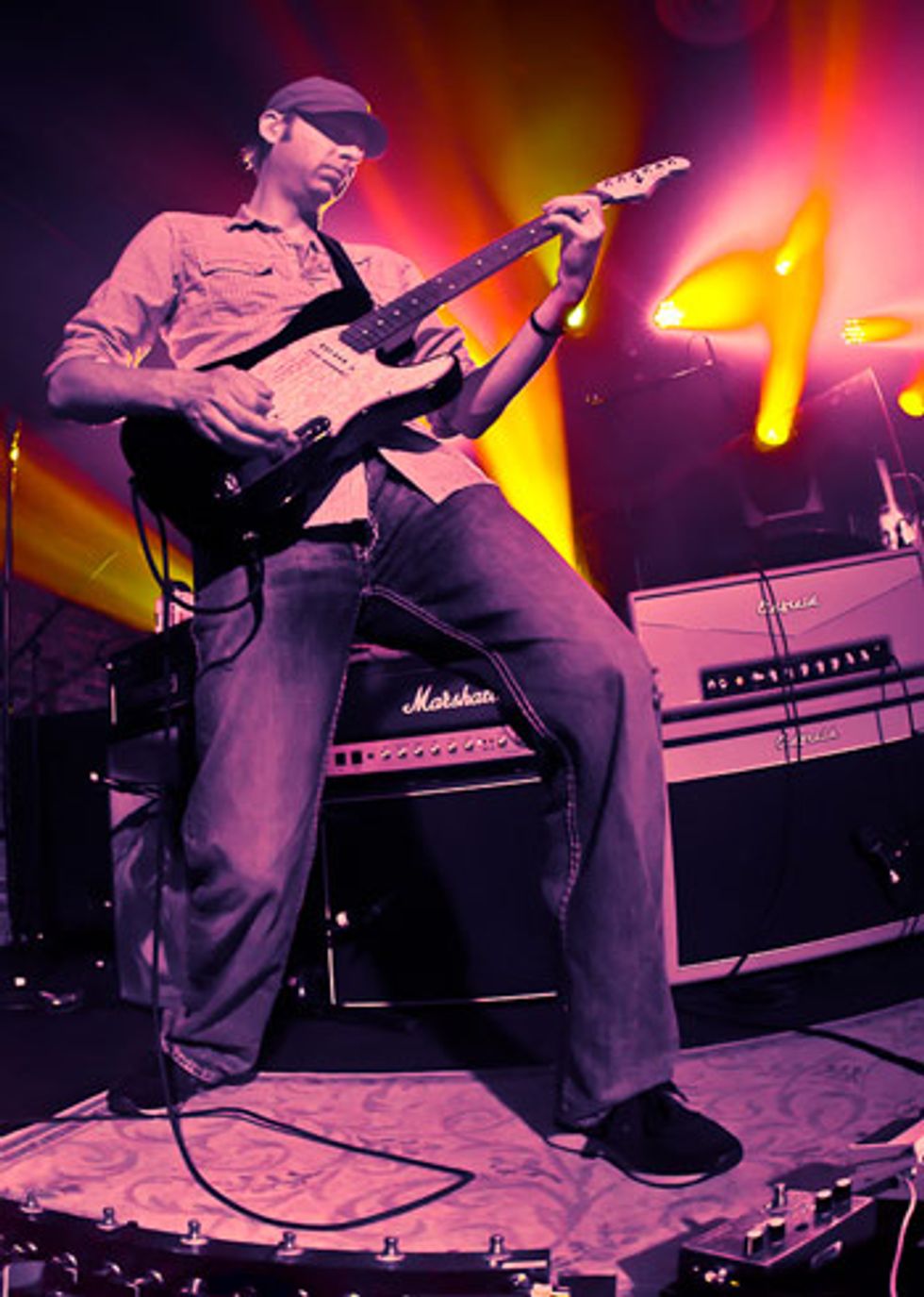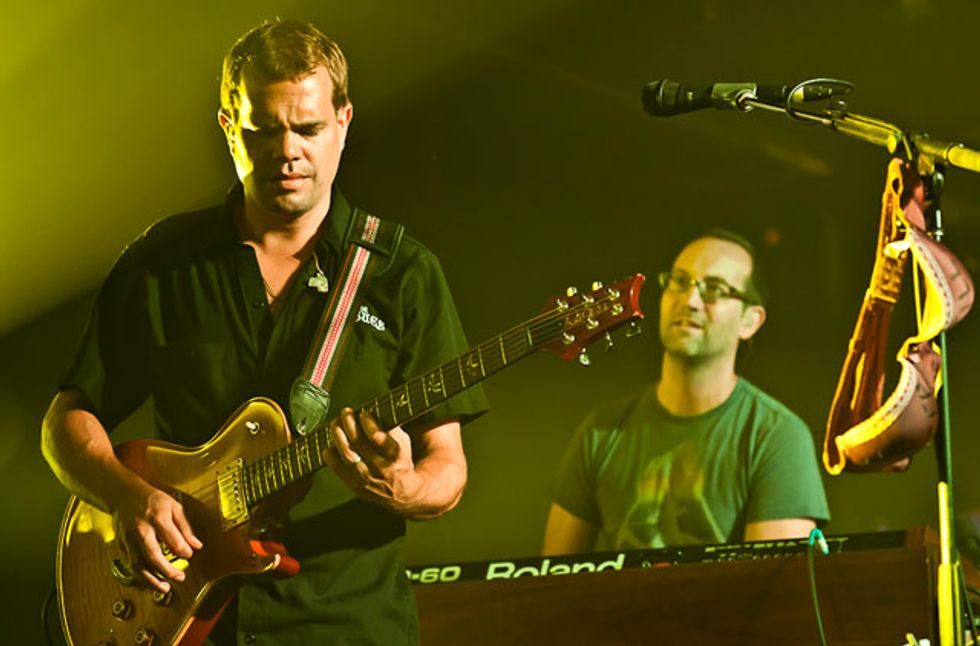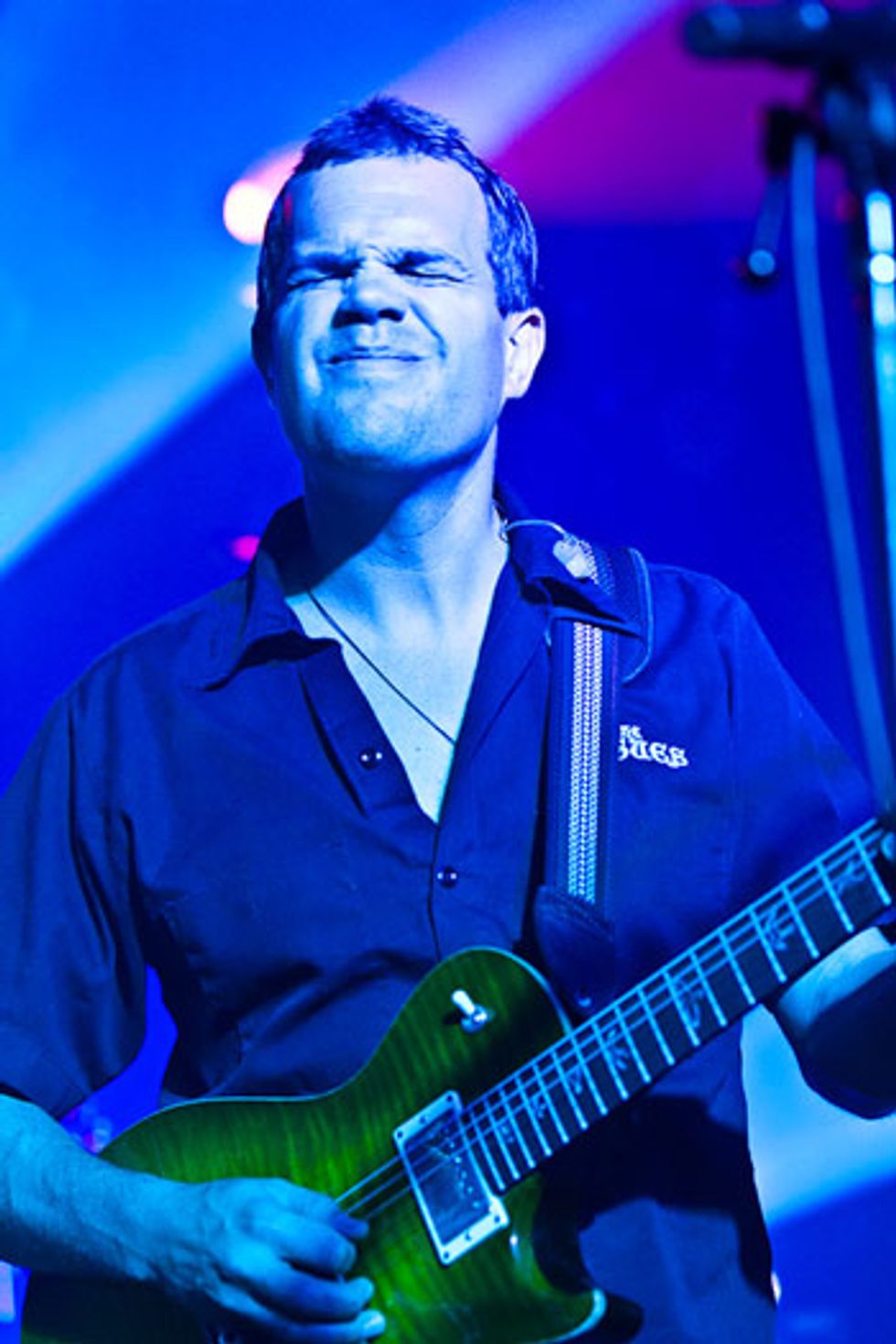| Click here to watch our Rig Rundown with Jake, Brendan, and bassist Ryan Stasick. |
This open-ended attitude translates to their studio albums as well. Each album showcases a combination of incredible chops, clever lyrics, and the fact that these guys have fun. Their more progressive influences came to a head with 2009’s Mantis, a sprawling, note-heavy experiment that, for the first time, contained material that hadn’t been fully road tested. The album was their most successful release to date and gave fans a side of Umphrey’s that hadn’t fully been explored. When it came time to record their follow-up album, not surprisingly, they took a different approach and dug out some tunes that came from the earliest days of the band.
With Death By Stereo, the band focused on the groove and took a more accessible approach to their sound. The opening track, “Miami Virtue,” is full of energy and hints at all the good parts of a dance tune from the ’80s. The band didn’t completely forget their hard-rocking roots evidenced by “Search 4,” a Jake Cinninger-penned tune that combines a drop-tuned riff with some ferocious playing by drummer Kris Meyers. We caught up with guitarists Jake Cinninger and Brendan Bayliss during their album release party to discuss how the Talking Heads influenced them, their live mashups, and why their latest album is all for the ladies.
What makes Death By Stereo different from your previous studio album, Mantis?
Jake Cinninger: This one was less focused than the last album, Mantis, where we were going for more of a storybook vibe. For this album, we just wanted to go through some of our songs and pick the ones that would sound great together. I think we worked on this record for about two years.
Brendan Bayliss: I would say Mantis was a lot more involved. The title track alone was twelve minutes long. It was a lot more progressive and—after that album—we talked about doing something that was more of a dance party to get some chicks moving. When we looked at the songs after the fact, we realized everything was shorter and much more accessible. That wasn't intentional—it just turned out that way.
On this album, you mixed both brand-new songs along with some you have been playing for a long time.
Jake Cinninger: It was nice to have a few, classic Umphrey's tunes that we could polish off and turn into a studio statement. When we would walk into the studio, the idea was to flesh out the songs to see how good a particular track could be and then work that idea out in the studio. I think we had about 12 or 13 tunes, but trimmed it back a little because now it isn't about putting out an 80-minute CD and trying to fit so much information in there. We wanted to make it short and sweet. Something you could just put on repeat.
Did your creative approach differ for this album?
Brendan Bayliss: The first track, “Miami Virtue,” came out of an improv. We were talking about how the Talking Heads would just jam for 20 minutes on some of their albums and then find a form or structure out of that. We were at Jake’s studio in Niles about a year ago and that track just came out of a jam.
Jake Cinninger: A lot of times we put so much thought and composition into the arrangement of our songs. On this record, we pulled that back and let the music breathe a little bit more. We didn't fill up all the measures with a million, black notes. We stepped back and shed the progressive-rock skin just a little bit.
What was it about those old Talking Heads albums that influenced you?
Jake Cinninger: Getting back to the simple structure of a song. When you go back to those old records, they are just so simple and they rock so hard. Removing the complications out of the equation really allows the song to take a nice left turn. Because we have so much going on with so many tunes in our repertoire, this particular record really felt nice to keep it sweet, simple, and fun.
Brendan Bayliss: A lot of the Talking Heads stuff is based on a groove. After Mantis, we wanted to make something that was more danceable. Some of that had to do by just talking about simplifying and not being so orchestral. Mantis was all over the place with a lot of left turns. It was probably harder for a hot chick to dance to that stuff, so we were thinking about simplifying it more for them.
It’s great that you are keeping them in consideration.
Brendan Bayliss: Well, we have to play 100 shows a year so it would be nice if it weren’t 100 percent dudes in the crowd.
 Photo: Jake Plimack |
Brendan Bayliss: Jake has a kick-ass studio and I have a very primitive studio in Chicago. He and I will both be writing during breaks and bring in skeletons of tunes. Jake will put in the bass, drums, keys, and everything—bringing in an almost finished product. The other way we write is just improvisation. A lot of times we will try and create A and B sections as a group. If they get really developed, we will start to improvise lyrics over them. Sometimes people will just bring in riffs and we will build a song around that riff.
Jake Cinninger: “Search 4” was pretty much all one of my compositions. “Wellwishers” was something that Bayliss had pretty much worked out fully. A song like “The Floor” would be a good example of all six of us throwing in some ingredients into one particular song.
Outside of Jake’s studio, where else did you record?
Jake Cinninger: A lot of the demos were done at my studio and then we went to I.V. Labs in Chicago, Manny Sanchez’s studio. We do most of our stuff there because he has been involved with us since day one. He is our go-to-producer guy and it’s close to home?
What did you do to prepare for those sessions?
Jake Cinninger: There is a lot of pre-planning before we record. We don’t want to waste a lot of time, so we really know the material inside and out before we walk into the studio. Generally, we want to track everyone live and then go back and sweeten things up and add vocals. The idea is to get that live-drum feel, with all of us playing in the room together, and then go from there.
How do you approach writing guitar parts for each other?
Brendan Bayliss: We have been writing together for 11 years. When I come up with a tune, I always think that there’s going to be two guitar parts. It comes naturally, because it’s always Jake and me. Typically, Jake will have something and it will have two parts already. He’ll be like, “Which part do you want? I’ll take this one, you take that one.” When you’re writing for the group, you are writing for the players in it and what they are going to do. It would be weird to just write three chords and hand it off.
Jake Cinninger: Exactly. For example, I will have a really nice chord progression that is kind of unusual and Bayliss will put a melody over top that completes the idea. Or vice versa.
“Booth Love” has a cool ’80s-feel with a great bass line.
Jake Cinninger: That wasn’t even supposed to make the record but it just flowered into a great groove with a really memorable vocal line. It just keeps repeating, almost like an A section with a little breakdown, much like an old James Brown funk tune. It's probably the easiest tune we have ever written.

Photo: Jake Plimack
“Hajimemashite” has been in your setlists for years. What prompted you to finally put it on an album?
Brendan Bayliss: “Haji” was one of the first songs we wrote as a band. We figured “let’s just record it,” just to have it. When we put the pile together, it fit even though it was never the plan to put it on the album. It’s a really old song and it offset some of the newer stuff.
How did “Dim Sun” come about?
Jake Cinninger: That was an accidental thing. Just the right place at the right time and hit the record button. I was waiting for the guys at the studio when we were doing the demos. It was a nice morning and there really wasn't any wind outside, so we dragged these old Telefunken microphones outside. You can hear the birds in the background. I came up with this strummy, Pink Floyd-vibe thing on an old Sears Silvertone acoustic from the ’50s that I swear even had the original strings. It was recorded in just one take and I did the overdubs with my Taylor. It was a little cooling of the jets in the middle of the record.
Do you ever bring in a tune and think it sounds too much like an influence?
Jake Cinninger: Yeah, I think we are all really cognizant of staying away from our influences and just letting them rub up against our pen. Once something is finished, you’re stuck with it forever. If something sounds really similar to something else, I think we really try to make an effort to flat or sharp a note just to force the difference.
Is there an example of that on this album?
Jake Cinninger: “Conduit,” for instance, has a little bit of a Led Zeppelin/Stone Temple Pilots feel with that big, half-time drum section and a descending riff where it just chromatically falls down. You throw in Bayliss’ vocal and it just instantly makes it Umphrey’s McGee. The little connections will make it sound like us by the time the finished product comes around.
On “Search 4” it sounds like Kris [Myers] is trying to audition for Metallica.
Jake Cinninger: That comes off as a more progressive Alice in Chains. We don't do too many “drop-D-rock-riff” sorts of things. That one really pops out as the prog-rock tune on the record and has the little Eddie Van Halen-style outro solo.

Did the gear you used in the studio differ from your live rig?
Brendan Bayliss: It did for me. I used a few Bogner amps, including a Shiva and an Ecstasy. I usually use a pedalboard on the road but for this album, it was just one pedal, usually a Pro Co Rat. We were trying to find a specific tone for that song and beat it to the ground. On “Search 4” and “The Floor,” I plugged straight into the head.
Jake Cinninger: I was pretty much using the kitchen sink at Manny's because he has tons of guitars on hand. I used my old Kramer American guitar quite a bit—an early-’80s American version of a Kramer. It's a real quality-made guitar—one of the ones made in Neptune, New Jersey. I was messing around with an old Silvertone Twin head, a really gritty-sounding head like the one Jack White uses. I also used my Fuchs Overdrive Supreme ODS-100 a lot for the clean sounds. Other than that, it was mostly whatever was banging around the studio that felt right at the time for the song.
What pedals did you use?
Jake Cinninger: Yeah, I used a Boss FZ-2 Hyper Fuzz that was all cracked up. I just found things would work better when it hit the clean stage of an amp. Certain pedals would break up a certain way or become more focused, and that’s what I was looking for. If I was going for a distorted sound, I would try to use the amp's distortion, because a pedal generally sounds like a pedal if you don't have the right one.
In your live rig, how do you divide the pedals between the amps?
Jake Cinninger: My clean amp has all the pedal options. If I want that Marshall crunch, I can just switch over to the B-side of the rig.
Brendan Bayliss: I pretty much have the same thing with my Mesa/Boogie Electra Dyne. Because it's so overdriven, you can't really use many effects through it. A delay would take off for two days.
Did you come across a sound in the studio that you implemented into your live rig?
Jake Cinninger: Actually, I used this vintage Morley EVO-1 pedal for the solo on “Domino Theory.” It didn't really sound like a regular wah because it had this phasing thing. It’s this big, nasty pedal that squeals and squelches making a sound like your guitar is puking. I can’t figure out how to get that sound anywhere else.
 Photo: Jake Plimack |
Jake Cinninger: Umphrey’s is obviously the most important thing on the plate, but because we have been together for so long, it’s kind of inevitable. We meet people on the road and other things come about. It just makes sense to get outside of the box to stretch our musical ideals in other directions and come back fresh. We are about to go out for a month with Umphrey’s and it’s nice to know that while we had fun with some other friends, it’s time to go back to work with my real band.
What side projects do you have coming up?
Jake Cinninger: I have the OHMphrey thing with Chris Poland and Robbie Pagliari from OHM. That band also has Joel [Cummins] and Kris from Umphrey's. We just recorded a record two months ago in Los Angeles and it should be out within a month or two on Magna Carta. I also have my old band, Ali Babba Tahini band that was the band I was in before Umphrey’s. We kick around and try to do studio recordings and live shows whenever we can.
Brendan Bayliss: I have a side thing with Ryan [Stasik] and two guys from the New Deal. It's called The Omega Moos and we basically do ’80s covers in a techno-style, wanting to make the tunes feel a little more modern. The other thing I have is 30db with the mandolin player from Yonder Mountain String Band, Jeff Austin, and the drummer from North Mississippi Allstars, Cody Dickinson. For me, one is a techno thing and the other is an acoustic thing, so that fulfills any desire I have to spread out. It covers all the ground, but anytime I do any of that, it makes me really appreciate what I have with Umphrey’s. It just feels like coming back home. The side projects are a lot of fun but there’s a little more work because you are back in a van, you're driving, moving your own gear, and playing for 200 people. Again, it makes you appreciate what you have with Umphrey’s.
Your live mashups are pretty legendary. How did those start?
Jake Cinninger: From hearing other DJs mash things together. We thought we could do the same thing since we have enough personnel in the band to pull it off. Half the band could be playing Tears for Fears and the rest of the band could be playing a Michael Jackson tune. The chemistry has to work as far as the chord progression, tempo, and melody, but if they are relatively close as far as chord progression, you can insert the melody. We do the homework, get 50 different possibilities together, and then we narrow them down by picking the best ones.
What was the most difficult one?
Jake Cinninger: The Rush/Journey mashup. “Spirit of Radio” and “Don't Stop Believin’” are pretty much the same chord progression in the verse. It was just so difficult to sing.
Brendan Bayliss: I still think it was good. It came off well. Sometimes it's really hard for us because it’s not like we are working on this stuff all year. We have enough on our plate that we can’t even think about the Halloween show until the leaves start changing. We start working on them a week or two out and we drill them. The hardest thing is to figure out what is going to work and then just committing to it.
What tune on the new album would you give to someone who has never heard Umphrey’s before?
Jake Cinninger: I would say “Conduit.” It has some cool little figures, along with some reggae and some rock, with a great melody that just sticks in your head. The vocal melody has a real earworm thing going on.
Brendan Bayliss: Just because it covers a lot of ground, I would say “The Floor.” It has an acoustic breakdown, it’s very dynamic, and there are some harmonies in there too. What we do can’t really be caught in one song, but between “Conduit” and “The Floor,” you get a pretty good example of what you can get from us.
| Jake Cinninger’s Gearbox Guitars ’90s G&L Legacy Mid-’80s Kramer American Special Series Effects Pedal-Racks True Bypass Strip Source Audio Soundblox Multiwave Distortion Source Audio Hot Hand Phaser/Flanger Tonebone Classic Marion-Henry Electric Fuzz Bucket BBE Free Fuzz BBE Mind Bender Moogerfooger Analog Delay Boss PS-5 Super Shifter Boss FZ-2 Hyper Fuzz Boss PH-3 Phase Shifter Boss TU-2 Chromatic Tuner Guyatone MD-2 Micro Digital Delay Steel Guitar Black Box MXR Distortion III Fuchs Plush Drive Morley ABY Morley EVO-1 Morley Bad Horsie Wah Amps Marshall 50-watt Vintage Modern 2266 Fuchs Overdrive Supreme ODS-100 Hard Truckers cab with Eminence Patriots Silvertone Twin 12 Strings D’Addario .010s | Brendan Bayliss’ Gearbox Guitars PRS Singlecut (nicknamed “Felica”) Effects Steel Guitar Black Box Morley ABY Morley Bad Horsie Wah Custom Audio Electronics Boost/Line Driver MXR Flanger MXR Phase 90 Cusack Tap-A-Whirl 2 Cusack Screamers Boss TU-2 Chromatic Tuner Boss CH-1 Super Chorus Boss OC-3 Super Octave Boss DD-20 Giga Delay Pro Co Rat Source Audio Soundblox Envelope Filter Stigtronics Delay Stigtronics Overdrive Amps and Cabs Mesa/Boogie Electra Dyne Oldfield Club 80 Hard Truckers cabinet Silvertone Twin 12 Bogner Shiva Bogner Ecstasy Vox AC30 Fender Twin Strings and Picks D’Addario .010s Telefunken 2mm graphite picks |












![Rig Rundown: Russian Circles’ Mike Sullivan [2025]](https://www.premierguitar.com/media-library/youtube.jpg?id=62303631&width=1245&height=700&quality=70&coordinates=0%2C0%2C0%2C0)












![Rig Rundown: AFI [2025]](https://www.premierguitar.com/media-library/youtube.jpg?id=62064741&width=1245&height=700&quality=70&coordinates=0%2C0%2C0%2C0)




















 Zach loves his Sovtek Mig 60 head, which he plays through a cab he built himself at a pipe-organ shop in Denver. Every glue joint is lined with thin leather for maximum air tightness, and it’s stocked with Celestion G12M Greenback speakers.
Zach loves his Sovtek Mig 60 head, which he plays through a cab he built himself at a pipe-organ shop in Denver. Every glue joint is lined with thin leather for maximum air tightness, and it’s stocked with Celestion G12M Greenback speakers.











